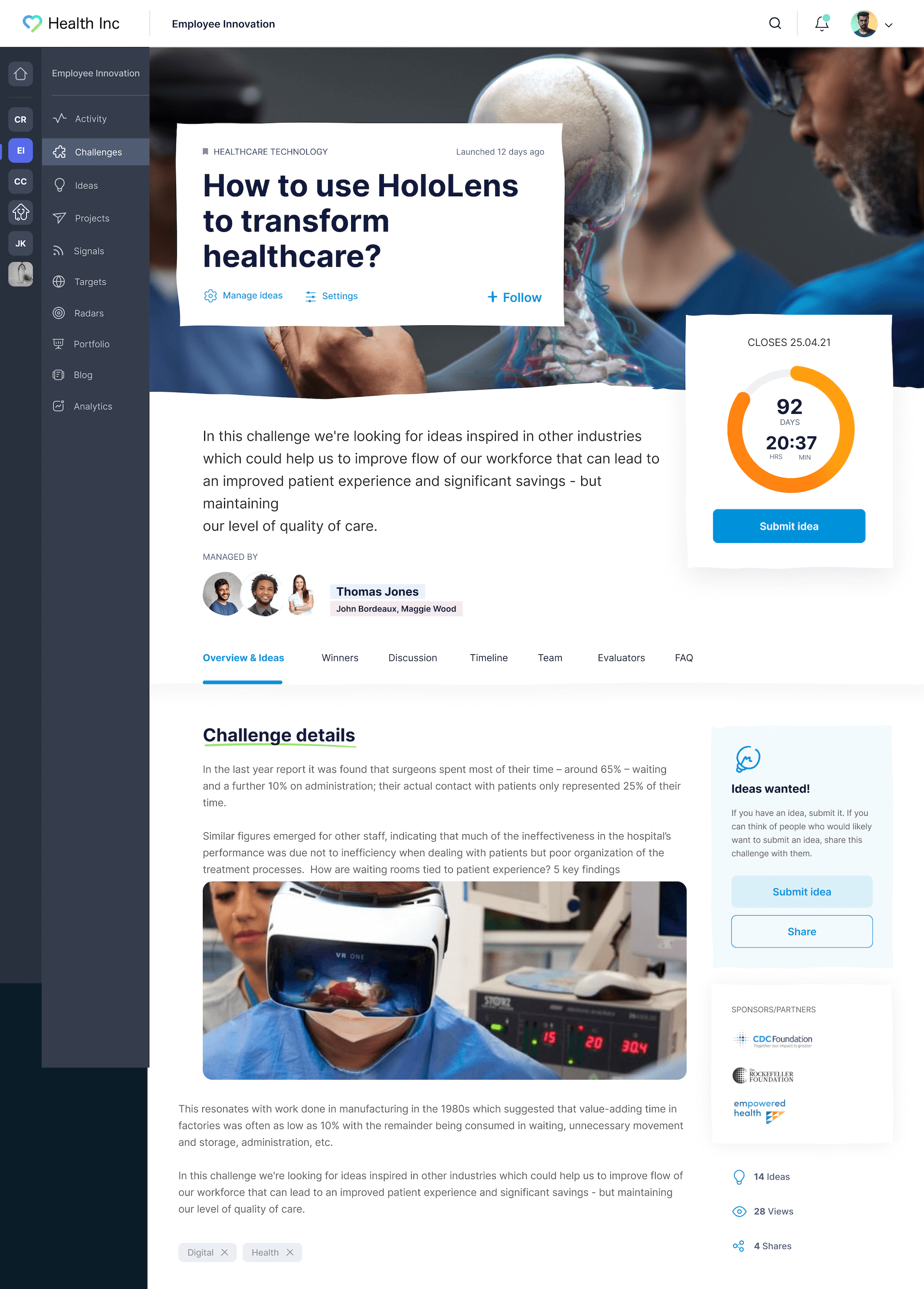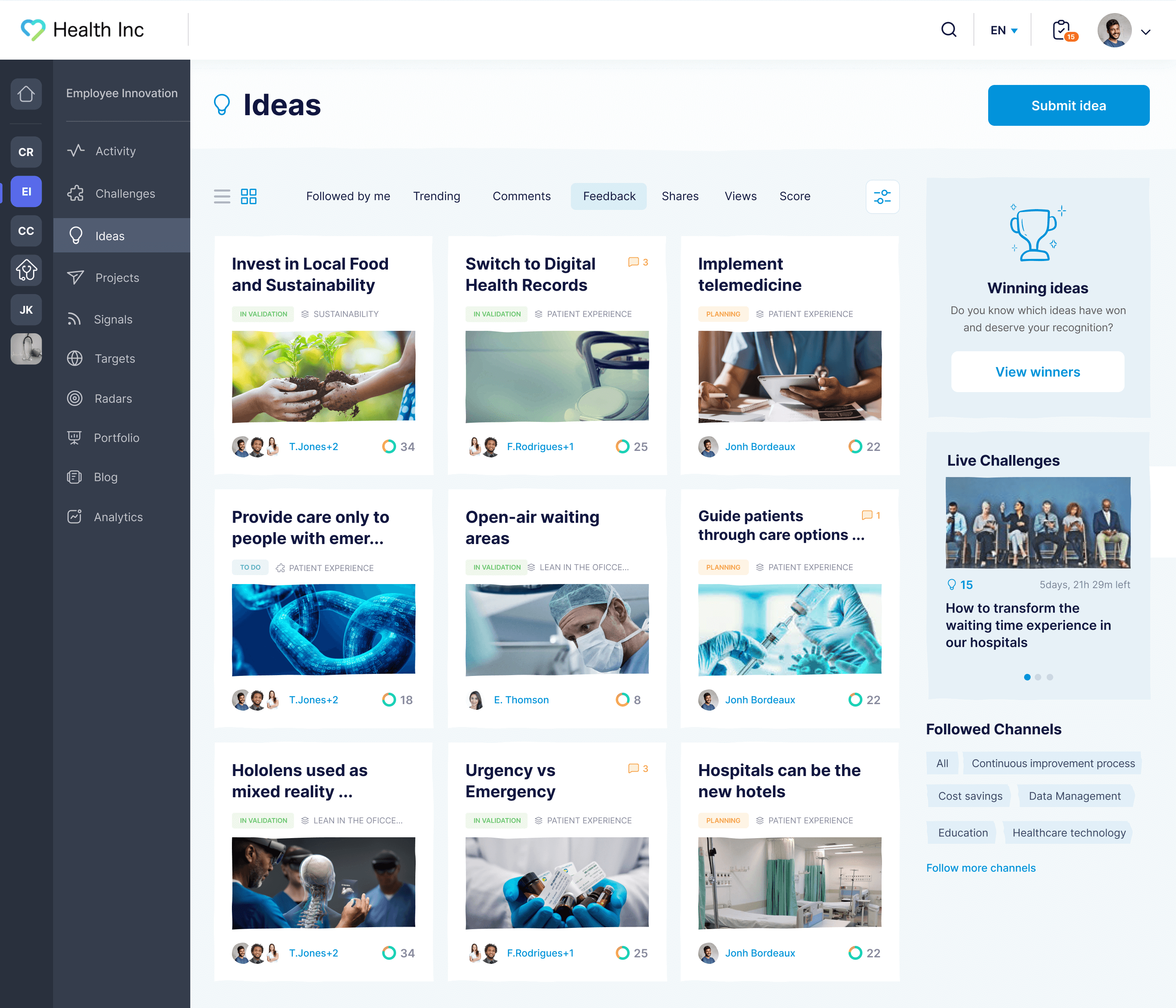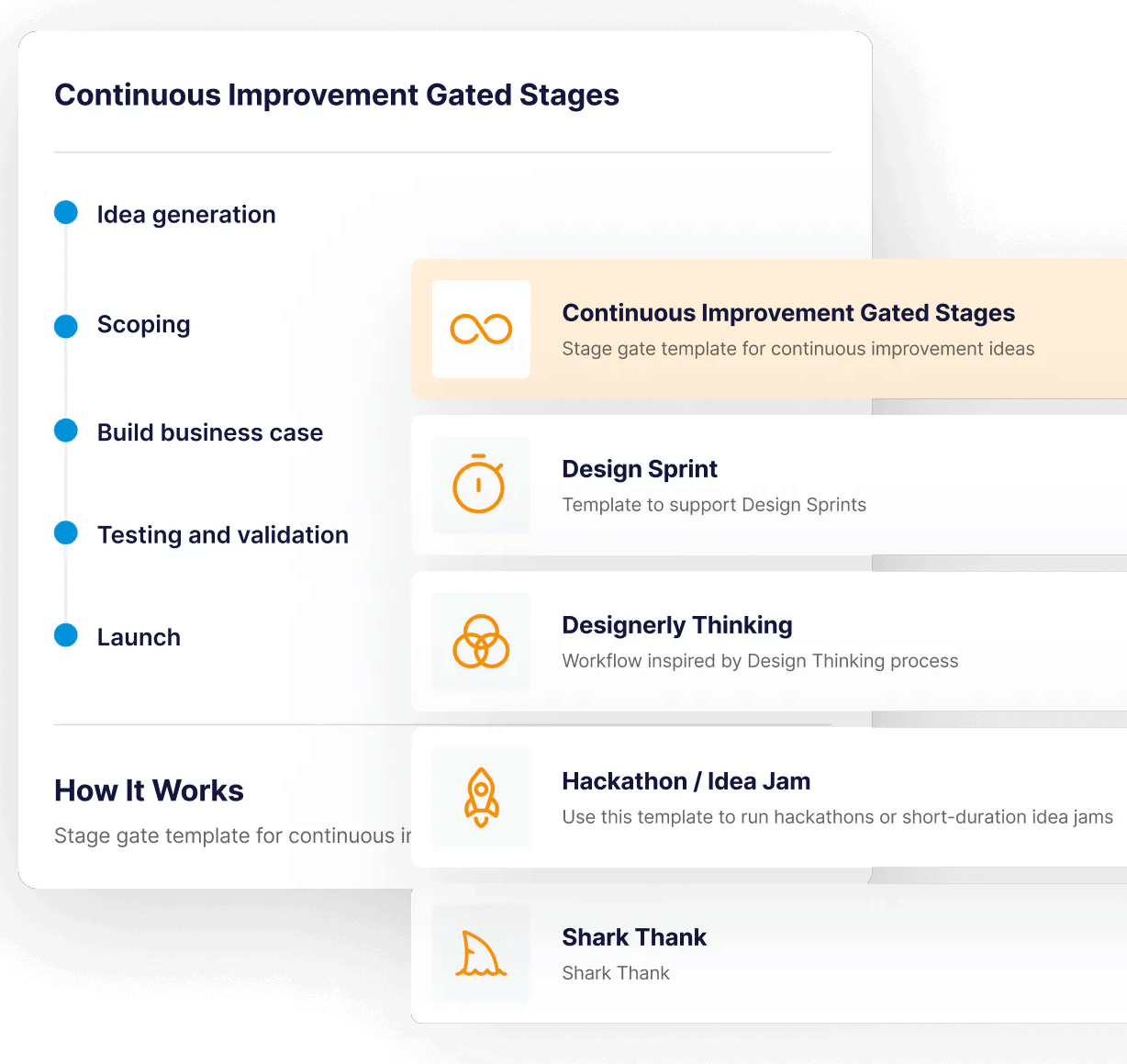Process innovation refers to the continuous improvement of how work is done within a company. This is usually achieved by introducing new software or machinery, adopting new methodologies, or redesigning work practices. These changes enable companies to achieve better, cheaper, and faster outcomes.
Here are a few examples of process innovation:
A customer support team spends 30 hours per week on customer support. So, they purchase chatbot software to automate responses to frequently asked questions, allowing them to spend just five hours a week on the phone.
A trucking company wants to cut costs and learns that fuel is one of its biggest expenses. So, it adopts route management software to minimize time on the road and save fuel.
In our 10+ years of experience as innovation managers, we’ve found that improving process inefficiencies typically involves six steps:
Idea collection: Department managers ask teams to identify process inefficiencies and suggest improvements.
Idea improvement: Ideas are posted in an idea management system where employees with diverse skill sets from various departments (finance, legal, digital transformation, data analytics, etc.) can view and refine them.
Idea evaluation: The department manager (or process owner) uses an evaluation model to determine whether an idea is worth pursuing.
Idea prioritization: Subject matter experts and stakeholders vote on which ideas to implement first based on their potential impact, profitability, level of risk, and importance to the company.
Idea validation: For high-risk, radical ideas, companies validate them by launching a pilot process, measuring its performance, and comparing it to existing processes.
Implementation: If an idea shows promise, the company launches the full-scale innovation. For simple process ideas, this may require purchasing a software license. For more complex ideas, the project management office develops a project plan with timelines, milestones, and implementation tasks.
Our guide reviews these process innovation steps in more detail, offering best practices and highlighting common mistakes to avoid.
Throughout, we explain how our innovation management platform, InnovationCast, supports companies in implementing effective process innovation.
Schedule a demo to see how InnovationCast can help your company continuously improve operational processes and support overall innovation efforts.
1. Don’t Crowdsource Ideas with a Suggestion Box; Inform Employees About Priorities and Focus Participation on Them
To identify inefficiencies, companies often crowdsource ideas by asking employees to highlight issues and suggest solutions.
While idea crowdsourcing can uncover process inefficiencies and innovative solutions, most companies approach it incorrectly.
Typically, they create passive channels like Slack, Google Forms, or email addresses for idea submission, lacking context and structure.
This suggestion box approach has three limitations:
Struggles to collect process innovation ideas: Employees may not know that process innovation is a priority or which processes need improvement, leading to irrelevant suggestions.
Generates generic, low-quality ideas: Without resources to help employees understand the initiative, ideas tend to be vague or already implemented.
Challenges in gathering a large number of ideas: With the suggestion box always open, there's no urgency for employees to submit ideas, limiting the overall quality.
With this in mind, we designed InnovationCast with a feature called Innovation Challenges, which helps companies source ideas aligned with their priorities.
How InnovationCast Supports Targeted Idea Collection
Innovation Challenges are time-limited invitations encouraging employees (and external users) to contribute ideas tackling the innovation strategy.
Department managers can post challenges informing employees that their priority is process innovation and limit participation to solely process ideas. Then, InnovationCast emails relevant users, prompting them to submit ideas.

This solves the three problems mentioned above:
Companies can direct employees’ attention toward process innovation or specific processes.
If companies know what processes they want to improve, they can attach additional context to the challenge, like efficiency reports and workflow diagrams. This enables employees to understand the process in detail and submit high-quality, specific ideas.
Since each challenge comes with a deadline (and InnovationCast periodically reminds employees when the challenge is about to close), employees get involved quickly. Companies can capture more ideas than an always-open Slack channel.
Unlike other challenge platforms, InnovationCast offers department managers templates, examples, checklists, and case studies on how to structure each challenge, helping them source the best ideas. This guidance is informed by our experience as innovation managers.
Additionally, our AI analyzes challenge content and suggests improvements. When an employee submits an idea, InnovationCast reviews their input and recommends ways to enhance it, resulting in more detailed submissions.
Our system also detects when an idea closely resembles a previously submitted one, prompting the employee to improve the original idea instead — saving managers from sorting through dozens of similar submissions.

Read more: How to Implement an Effective Idea Generation Process in Your Organization
2. Use the Collective Intelligence of the Entire Workforce to Improve Ideas
Ideas are often incomplete when first submitted, and the proposed solutions may not be the best. That’s why successful companies typically put ideas through an improvement step after collection.
During idea improvement, employees, stakeholders, and outside experts can view and refine submissions, offering alternative solutions for addressing process inefficiencies. This approach taps into the know-how of employees across the company, fostering more polished ideas.
To support this, organizations need a centralized idea management system that houses all ideas, allowing everyone to provide feedback.
Most companies don’t centralize innovation — different departments collect ideas using different tools (spreadsheets, surveys, email inboxes), limiting collaboration and idea optimization.
How InnovationCast Supports Idea Improvement
Whenever someone submits an idea, InnovationCast showcases it on the news feed for all departments to see upon logging in. It also notifies users when colleagues submit ideas, encouraging co-creation and problem-solving.

Users can express their opinions on a process idea by voting and selecting options like “Looks good,” “Not so good,” or “Undecided,” indicating they need more information.

Unlike most innovation tools, where users simply vote without encouraging improvement, InnovationCast prompts users to explain their vote. For example:
What specific aspects of the idea are appealing or unappealing?
Are there any particular concerns that influence your perception of the idea?
This fosters discussions on factors like customer needs, competitiveness, and production processes, allowing ideas to be refined with input from the entire workforce’s expertise.
Read more: How to Encourage Innovation in the Workplace
3. Decide Which Process Ideas to Move Forward with Using an Evaluation Model
After process ideas are improved, they are typically assessed by the department manager or a select group of decision-makers using an evaluation model to determine whether to approve or reject the idea.
An evaluation model is a set of guiding questions that evaluators answer using their expertise to make informed judgements. If approved at this stage, the idea moves directly to implementation.
Based on our experience, a model that works well across various idea types (business process ideas, product innovation ideas, customer experience ideas, business model innovation ideas, etc.) is RICE:
Reach: What is the potential reach of this idea? How many people could it impact?
Impact: What impact could this idea have on the company?
Confidence: How confident are you in executing the idea and realizing the benefits?
Effort: What level of effort is required to implement the idea?
However, if the idea involves more risk and uncertainty, and the evaluators cannot answer the questions in the evaluation model — for example, replacing the entire assembly line with robotics — the idea is sent to validation (more on this below).
How InnovationCast Supports Idea Evaluation
Within InnovationCast, idea evaluators have access to multiple workflows to guide their decision-making. These workflows include various evaluation models, criteria, screening questions, business scorecards, and recommended participants based on the type of idea.
This support ensures that evaluators don’t have to approve or reject ideas on their own.

Idea evaluators can customize these workflows based on their preferences, selecting the questions, criteria, and scorecards they want to use. With a simple drag-and-drop interface, these workflows offer flexibility while serving as a helpful starting point for users unsure about how to evaluate ideas.
Read more: Best Practices to Evaluate Innovation Ideas
4. Have Stakeholders Vote on the Order of Implementation for Ideas
Companies will likely receive multiple high-quality ideas for each challenge, provided they follow the correct steps in evaluation.
However, implementing every idea at once is often impractical. It could disrupt current processes (requiring employees to use multiple pilot processes and report on their findings), and the company likely doesn’t have the budget to pursue each idea simultaneously.
This is where idea prioritization comes in. Process managers and key decision-makers will vote on which ideas to implement first, with criteria typically based on the idea’s potential impact, competitive advantage, risk level, and alignment with company priorities.
How InnovationCast Supports Idea Prioritization
InnovationCast includes a voting feature that enables users to invite stakeholders to view the details of each idea and vote on the preferred order of implementation. The winning ideas are then moved forward, while the runners-up are set aside for future consideration.

5. Validate High-Risk, High-Uncertainty Process Ideas Before Implementing Them
Process validation refers to running experiments to test whether ideas will work. This typically involves giving a few employees access to a pilot process, analyzing the efficiency of the new process, and comparing it to the existing one. For example, did it save employees time? Did it lower operational costs?
Most process ideas don't undergo validation because they are low-risk, data-supported improvements. If these ideas fail, the company is unaffected, and department managers can simply revert to the previous process. These ideas move directly to implementation.
However, some process ideas will significantly impact the company if they fail. Think of adopting new technologies like expensive, automated robotics to improve manufacturing processes. In these scenarios, companies will validate ideas before implementation.
Department or innovation managers usually assemble ad hoc validation teams consisting of the idea author, co-authors, and perhaps employees with specific skill sets.
Then, companies give validation teams a budget to launch the prototype process and monitor efficiency gains. If they can prove that the new process works better than the current one, the full-scale process gets implemented.
A key mistake to avoid is leaving teams to figure out idea validation on their own. While they may be experts in their respective industries, they aren't experts at idea validation and innovation management. Without guidance, they often rely on trial and error to validate ideas, leading to failed projects and wasted resources.
Organizations can assign an innovation manager to guide validation projects. However, because innovation departments are often underfunded and understaffed, they cannot support every validation. Instead, organizations with successful innovation programs use innovation management software to help teams navigate the validation process effectively.
How InnovationCast Supports Idea Validation
We designed InnovationCast with tailored validation workflows, frameworks, and templates to guide teams through the necessary steps after idea collection, ensuring they aren’t left to figure things out alone.
Moreover, we offer workflows specially designed for various types of process innovation ideas (e.g., cost reduction, lean manufacturing, supply chain, customer satisfaction), preventing teams from being forced into the same generic workflow common on other innovation platforms.

These process improvement workflows are designed using our decade-plus experience as innovation managers and our learnings as to what works and what doesn’t. Additionally, they are inspired by innovation methodologies like Discovery-driven Planning, Lean Startup, Product Development, and Value Proposition Design.
Read more: Idea Validation: A Guide to Affordably Testing Ideas
6. Implement the Full Scale Innovation
The final step in the innovation process is implementation, and the steps involved vary depending on the idea’s nature. For simple, low-risk ideas, such as the accounting team needing new bookkeeping software, implementation may involve the accounting manager purchasing the new product and training staff members on how to use it.
For more complex ideas, such as a manufacturer replacing assembly lines with robotics, the idea is typically sent to the project management office. They then manage implementation by sourcing robotics suppliers, developing algorithms, training the artificial intelligence, and installing the machinery.
Identify and Address Process Inefficiencies with InnovationCast
If you’d like to learn more about the benefits of process innovation and how InnovationCast can help you establish the steps mentioned above, schedule a free demo.
Related reads:

